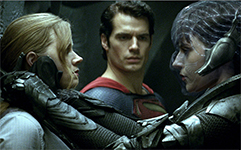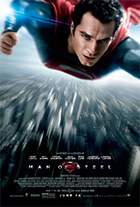Man of Steel
|  When Bryan Singer tried to reboot the Superman film franchise back in 2006 with Superman Returns, he made the film a self-conscious extension of the world created in Richard Donner’s Superman (1978) and Richard Lester’s Superman II (1980) by picking up where those films left off and adopting their general aesthetic. He even went so far as to borrow John Williams’s iconic fanfare, replicate the pop-art colors of Geoffrey Unsworth’s cinematography, and cast Brandon Routh for his physical and vocal similarities to Christopher Reeve. The film, despite making hundreds of millions of dollars worldwide and generating mostly favorable reviews, was nevertheless seen as a disappointment and failed to reignite the franchise. It turned out that people wanted something different, and Singer’s nostalgic vision was too retro for its own good. When Bryan Singer tried to reboot the Superman film franchise back in 2006 with Superman Returns, he made the film a self-conscious extension of the world created in Richard Donner’s Superman (1978) and Richard Lester’s Superman II (1980) by picking up where those films left off and adopting their general aesthetic. He even went so far as to borrow John Williams’s iconic fanfare, replicate the pop-art colors of Geoffrey Unsworth’s cinematography, and cast Brandon Routh for his physical and vocal similarities to Christopher Reeve. The film, despite making hundreds of millions of dollars worldwide and generating mostly favorable reviews, was nevertheless seen as a disappointment and failed to reignite the franchise. It turned out that people wanted something different, and Singer’s nostalgic vision was too retro for its own good.Enter Christopher Nolan and David S. Goyer, the respective director and co-writer of the hugely successful Dark Knight trilogy, which not only reanimated the Batman franchise after the twin debacles of Joel Schumacher’s campy Batman Forever (1995) and campier Batman & Robin (1997), but recalibrated the entire notion of what a superhero movie could look and feel like with its existential angst, emotional unease, and gritty tone. Man of Steel, which Nolan produced and Goyer wrote, has a similar look and feel, which marks it as a decidedly different kind of Superman film—certainly a far cry from Singer’s more upbeat brand of revisionism (the initially released stills from the two films are telling, as Superman Returns was heralded by a bright image of Superman lifting a car over his head in homage to the cover of Action Comics #1, while Man of Steel’s look was first revealed in a dark image of Superman emerging, scowling, from a huge metal door into which he has been hurled). The titular use of Superman’s metaphorical nickname rather than his superhero moniker—a move clearly borrowed from the Dark Knight trilogy—immediately confers on the film an air of literary gravitas and declares the filmmakers’ intent to stake out new territory. Yet, the film’s fundamental idea—to take Superman as a character seriously—is not new at all, as that is precisely what Donner did back in 1978 when he envisioned him as recognizably, vulnerably human despite his physical imperviousness, which is why casting then-unknown Christopher Reeve was such a stroke of genius. While it may not be a new idea, it is a good one, and Man of Steel is at its best when it remains character-focused. The director, Zack Snyder, is not exactly known for his subtlety or humanity; his best-known films are the graphic novel adaptations 300 (2007), a near-fascist celebration of violent masculine prowess, and Watchmen (2009), a critical deconstruction of superheroics, and his most recent film was Sucker-Punch (2012), an asinine, retrograde adolescent male fantasy that looks up skirts and down gun barrels in equal measure. A gifted visual stylist, Snyder has nevertheless remained largely mired in sophomoric slow-motion violence, body worship, and music-video bombast, which is why it is so surprising that Man of Steel’s best moments are also its quietest. Significant portions of the film are dedicated to flashbacks of Clark Kent’s often painful adolescence, which Snyder treats with a poignant grace that elevates the material into something very nearly poetic. We see this particularly in a scene in which young Clark finds himself overwhelmed by his super-abilities while at school—being able to see through everything and hear everything simultaneously creates a tsunami of sensory overload that drives him into a closet, isolating him from his peers who simply think he’s weird. It’s a beautiful and moving evocation of the pains of being different and the inability of others to understand (except, of course, a loving mother). Given all the film’s Christ references (Superman is 33 years old when he takes on his superhero identity, and at one point he is framed with a stained glass portrait of Jesus over his shoulder), the scene makes one think of The Last Temptation of Christ and how Nikos Kazantzakis imagined Jesus’s simultaneous humanity and divinity as a source of unrelenting torment. The beauty of the flashback sequences is enough to make one wish that the entire film had focused on Clark’s childhood, but unfortunately that is not the case. Instead, Man of Steel is bookended with obnoxious visual overload, beginning with the opening sequences on the distant planet Krypton that play like a mash-up of design outtakes from The Lord of the Rings and the Star Wars prequels. A far cry from the austere, modernist aesthetic that production designer John Barry gave to Krypton in Donner’s film, the Krypton in Man of Steel is a bronzed fantasy world of laser guns, enormous ships, and flying dinosaur-creatures. It is here that we are introduced to Jor-El (Russell Crowe) and Lara Lor-Van (Ayelet Zurer), who send their infant child Kal-El (He-Who-Will-Become-Superman) Earth-bound just before the planet is destroyed. In previous incarnations of the story, Krypton was destroyed because a shift in its orbit brought it too close to the red sun around which it revolves, but here it collapses because the Kryptonians, having otherwise exhausted their natural resources, have begun plundering the planet’s very core for energy, a more relevant idea for today’s environmentally conscious times. In addition to the planet’s impending doom, the people of Krypton are also dealing with an attempted coup by General Zod (Michael Shannon), a militaristic hawk who takes it upon himself to save the planet by ensuring the survival of only those he deems genetically superior (he and the Spartans of 300 would have gotten along fabulously, even though he’s the villain here and they were the ostensible heroes of that movie). Once on Earth, Kal-El is raised by Jonathan and Martha Kent (Kevin Costner and Diane Lane), a kindly Kansas couple who love him dearly, but also instill in him the hard lesson that humanity might not respond very well to his abilities (people always fear what they don’t understand). Jonathan is particularly fearful of what might happen to Clark if his powers were to be discovered, and his insistence that his adopted son hide what he can do reaches a powerful climax when Clark has the opportunity to save him, but doesn’t, lest he reveal his true nature. Yet, Clark can’t keep his abilities entirely under wraps, and as a young man (played with a mix of physical authority and emotional pathos by chiseled British actor Henry Cavill) he leads a rootless, wandering existence, moving from place to place until a situation arises that demands a superhuman response, thus forcing him to move on. It is during these wanderings that he first comes across Lois Lane (Amy Adams), an intrepid reporter for The Daily Planet who becomes his first true ally and confidant, an interesting twist on the long-standing narrative that has her simultaneously in love with Superman and blithely dismissive of his human alter ego. The action in the story derives from the arrival of General Zod and his cohort of surviving Kryptonian dissenters, who want Clark because he holds the key to recreating their beloved home. Zod’s plan involves terraforming Earth and turning it into a new Krypton, which necessarily entails the destruction of everything and everyone on the planet. Thus, Superman is faced with the dilemma of embracing his adopted humanity or reuniting with the remnants of his true race, a moral predicament that unfortunately carries very little weight because, by this point in the film, the main focus is on destruction, destruction, and more destruction. Superman’s battles with Zod and his minions (including Antje Traue’s menacing Faora-Ul) first decimate most of downtown Smallville before shifting to the towering skyscrapers of Metropolis, many of which come tumbling down after Zod turns on his massive terraforming machine. Images of glass skyscrapers collapsing, massive clouds of concrete dust billowing through the city streets, and ash-streaked citizens running for their lives invariably invokes the horrors of 9/11, but unlike, for example, Steven Spielberg’s masterful War of the Worlds (2005), there’s no subtext or sense of gravity. It’s just destruction for destruction’s sake, a meaningless demolition derby of epic proportions. While expertly rendered by the film’s army of special effects artists, the violence feels simultaneously bloated and empty, yet another exercise in wide-scale cinematic decimation without any sense of humanity or the weight of its loss. Had the film been a Roland Emmerich-style exercise in self-consciously gratuitous destruction, we might be able to turn a blind eye and engage the spectacle, but the filmmakers’ insistence that we take this all seriously demands something more, something they are unwilling to engage. The moral issue is certainly perplexing, as all those falling buildings are likely killing thousands of people, none of whom are given even a second thought, but there is also the issue of artistic banality: So many modern action films end in this manner, from Michael Bay’s deadening Transformers movies to Joss Whedon’s The Avengers (2012), that the impact of entire city blocks being turned into rubble is virtually nonexistent. The action bludgeons and eventually deadens our senses both physically and morally, which is why, when the film does turn its attention to saving lives as Superman fights to keep Zod’s laser vision from skewering a cowering group of civilians, it feels tacked-on and phony, a last-minute bit of moralizing to help us forget the invisible thousands who were already bloodlessly sacrificed at the altar of PG-13 destruction porn. The film’s most absurd moment, the one that truly encapsulates the meaninglessness of its violence, arrives when Lois exclaims to Superman “You saved us!” as they both stand in an apocalyptic wasteland at the center of Metropolis. Surrounded by death, her cliché exclamation, like so much of the film’s overextended action, rings painfully, thunderously hollow. Copyright ©2013 James Kendrick Thoughts? E-mail James Kendrick All images copyright © Warner Bros. |
Overall Rating: 

 (2.5)
(2.5)


